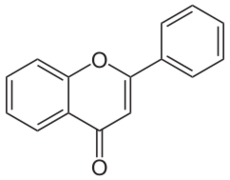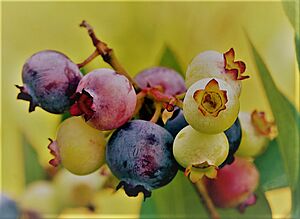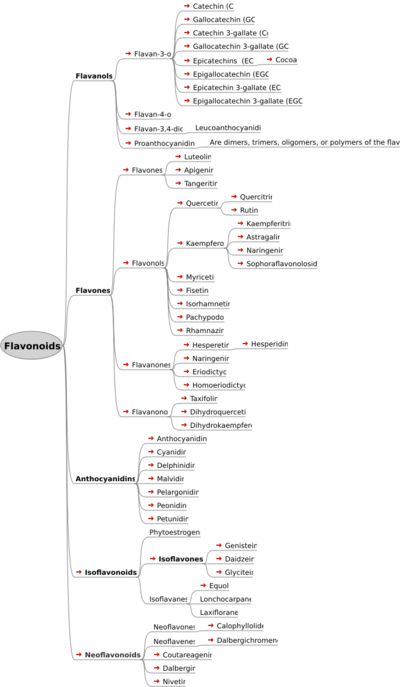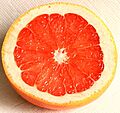Flavonoid facts for kids
Flavonoids (also known as bioflavonoids) are natural substances made by plants. The name comes from the Latin word flavus, which means yellow, because many of these compounds are yellow. Flavonoids are a type of polyphenol and are a normal part of the human diet because they are found in so many fruits, vegetables, and other plants.
Chemically, flavonoids share a similar 15-carbon structure. This structure is made of two phenyl rings (named A and B) and a special ring containing oxygen (named C). Based on small differences in this structure, scientists group flavonoids into different types, including:
- Flavonoids (or bioflavonoids)
- Isoflavonoids
- Neoflavonoids
These compounds are what give many flowers, fruits, and leaves their vibrant colors.
Contents
A Brief History of Flavonoids
In the 1930s, the scientist Albert Szent-Györgyi (who also discovered Vitamin C) noticed something interesting. He found that pure Vitamin C was not as good at preventing a disease called scurvy as a simple, yellow extract from oranges or lemons.
He and his team believed that other substances in the extract were helping Vitamin C do its job. They called this mix of substances "citrin" (from citrus fruits) or "Vitamin P," because it seemed to make tiny blood vessels (capillaries) less leaky.
However, scientists later discovered that these substances, like hesperidin, didn't fit the definition of a vitamin. Today, the term "Vitamin P" is no longer used, but the discovery sparked interest in studying these amazing plant compounds.
Why Do Plants Make Flavonoids?
Flavonoids are very important for plants and have many different jobs.
- Creating Colors: Flavonoids are like paint for plants. They create the bright yellow, orange, red, and blue colors in flower petals. These colors attract bees, butterflies, and other animals that help with pollination.
- Sunscreen for Plants: Just like people need sunscreen, plants need protection from the sun's harmful ultraviolet (UV) light. Flavonoids act as a natural filter to protect the plant's cells from UV damage.
- Helping with Growth: Flavonoids can act as messengers inside the plant, helping to control its growth and life cycle.
- Working with Soil Microbes: Some plants, like peas and beans, have a special relationship with bacteria called Rhizobia. The plant's roots release flavonoids into the soil, which signals the bacteria to come closer. The bacteria then help the plant get important nutrients, like nitrogen, from the soil.
- Plant Defense: Flavonoids can also help protect plants from diseases caused by fungi and other harmful organisms.
Main Types of Flavonoids
There are over 5,000 different flavonoids known to science. They are usually grouped based on their chemical structure. Here are some of the most common groups:
- Anthocyanins: These are pigments that create the red, purple, and blue colors in many plants. You can find them in foods like blueberries, raspberries, black rice, and red cabbage.
- Flavones: These are often found in celery, parsley, red peppers, and chamomile.
- Flavonols: These are very common in our diet. A well-known flavonol is quercetin, which is found in onions, kale, apples, and tea.
- Flavanones: These flavonoids are responsible for the bitter taste of citrus peels. They are found in high amounts in lemons, oranges, and grapefruits.
- Flavan-3-ols: Also known as catechins, these are found in green tea, black tea, cocoa, grapes, and apples.
- Isoflavones: This group is most famous for being in soybeans and other soy products, like tofu.
Where Can You Find Flavonoids?
Since flavonoids are made by almost all plants, it's easy to find them in food. Eating a diet rich in fruits and vegetables will give you a good amount of many different types of flavonoids.
Foods that are especially high in flavonoids include:
- Herbs and Spices: Parsley and thyme
- Vegetables: Onions, kale, and broccoli
- Fruits: Blueberries, strawberries, bananas, apples, and citrus fruits like oranges and grapefruits
- Drinks: Black tea, green tea, and red wine
- Other Foods: Buckwheat, dark chocolate, and the red skin on peanuts
The amount of flavonoids can be different in different parts of a plant. For example, the peel of an orange or clementine has much more flavonoids than the juicy pulp inside.
-
Flavonoid Content in Some Common Foods (mg per 100g) Food Source Flavones Flavonols Flavanones Red onion 0 4–100 0 Parsley, fresh 24–634 8–10 0 Thyme, fresh 56 0 0 Lemon juice, fresh 0 0–2 2–175
What Happens When We Eat Flavonoids?
When you eat foods with flavonoids, your body doesn't absorb them very well. Studies show that less than 5% of the flavonoids you eat enter your bloodstream. The ones that are absorbed are broken down very quickly and removed from the body.
Because they are not absorbed well, their direct effect as antioxidants in the body is small. The antioxidant boost seen in blood after eating flavonoid-rich foods is mostly due to an increase in uric acid, which is a byproduct of the body breaking down the flavonoids.
Research on Flavonoids and Health
Scientists are very interested in how flavonoids might affect human health, but a lot of research is still needed.
For example, some studies have looked at flavonoids and heart health. In 2013, the European Food Safety Authority (EFSA) allowed a health claim for flavanols from cocoa. The claim states that eating 200 mg of cocoa flavanols per day "helps maintain the elasticity of blood vessels." The U.S. Food and Drug Administration (FDA) agreed in 2023 that there is some evidence for this, but it is not conclusive. It is important to remember that chocolate bars also contain sugar and fat, so getting flavanols from dark cocoa powder might be a healthier choice.
For other health areas, like cancer or inflammation, there is not enough strong evidence from human studies to say that eating flavonoids can prevent or treat any disease. No health agency has approved flavonoids as prescription medicines.
Images for kids
See also
- Phytochemical
- List of antioxidants in food
- Secondary metabolites















